|
|
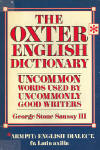 |
|
|
[Quotations and
Response "from Guy Davenport"]
in George Stone Saussy III, comp. The
Oxter English Dictionary:
Uncommon Words Used By Uncommonly Good Writers. New York, NY; Bicester,
England: Facts on File Publications, 1984. 277 pp.
Saussy provides 86 "uncommon words" used by
Guy Davenport in Tatlin!, Da Vinci's Bicycle, and
Eclogues ("Sources" p. 276) as follows:
| 3-5 |
62 |
109 |
149 |
202 |
| 7 |
64 |
114-115 |
154 |
206 |
| 13 |
68-69 |
116-117 |
156-158 |
212 |
| 16 |
72 |
120 |
161-162 |
220-222 |
| 17 |
82 |
122-123 |
165 |
240 |
| 24-25 ; 27 |
86-87 |
125 |
167-168 |
252 |
| 36-37 |
91-92 |
128 |
170 |
264-265 |
| 39 |
95 |
136-137 |
173 ; 178 |
-- -- -- -- -- --
-- |
| 46 ; 50 |
99-100 |
139 |
185-188 |
response: 272 |
| 59 |
106-107 |
142-143 |
196-197 |
sources: 276 |
Saussy provides some "Authors' Responses"
(pp. 271-272). GD's response (p. 272):
Each of my ravings has its own range of
diction (I like to think). I like a texture suitable to my subject. In
'The Dawn in Erewhon,' as elsewhere, I had to solve the problem of
describing things and events for which the received concepts and words
were unacceptable to me. Obviously I rand the risk of being
'precious,' but then I don't consider myself a writer. I don't expect
to be remembered as one, but as an experimenter who searched out some
alternatives in style and subject matter.
Diction is color
range, texture, technique. In my new book, for example, Apples and
Pears, I assigned a range of diction to first violin, another to
second violin, another to viola, and another to bass viol, for the
sense of a quartet. I don't expect anybody to see this: it was a
device that kept me knowing what kind of word I had to have at
any one place, and what kind of music I was making with my imaginary
string quartet. (It is also a text -- it's part of Adriaan van
Hovendaal's Erewhonisch Schetsboek mentioned upfront in
Tatlin! as a source for 'The Dawn in Erewhon' -- written in
English by a highly-literate Dutch-speaker, so that an English word
with a Dutch cognate is always chosen over the better-known English
word, and words for which van Hovendaal doesn't know the idiomatic
English are in Dutch."
"Uncommon Words" included in Saussy's
Dictionary, defined and with the context in which Davenport used
them (the first two serve as examples of the complete entry for a word):
- AGON -- 3 noun
A public celebration consisting of competitions and games.
"But the Spartans do not like a game in
which the defeated concedes that he has lost. It seems to them to be
giving up, even though there are four more agons." (Davenport, 'The
Daimon of Socrates,' Eclogues, p. 76)
- AITHOCHROUS -- 4
adj [ective] reddish-brown, ruddy
". . . a boy as
splendid and aithochrous as the Cnossan striplings wrestling among
blue flowers on Minos' walls. . . .
(Davenport, 'The Dawn in Erewhon,' Tatlin!, p. 253)
- AKROPOSTHION -- 4-5
- ALLELLOMORPH -- 7
- ANTINOAN -- 13
- APTERYX -- 16
- ARMSCYE -- 17
- BAUBON -- 24-25
- BLORE -- 27
- CAMBER -- 36
- CARDIOID -- 37
- CELADONY -- 39
- COCKET -- 46
- CONSILIENT -- 50
- CULLION -- 59
- DARB -- 62
- DEINOSIS -- 64
- DIASTASIS -- 68
- DOLICHOPHALLIC -- 72
- DOWSET ; DOUCET --
72
- EPDICTIC ;
EPIDEICTIC -- 82
- EUPHROSYNE ;
EUPHRASY -- 86
- EUTRIPSIA -- 86-87
- FARL -- 91
- FASHED -- 92
- FIORITURA -- 95
- FRANION -- 99
- FRATCH -- 100
- FREMITUS -- 100
- GALLINACEOUS -- 107
- GASTER -- 107
- GLABROUS -- 109
- GLANDES ; GLANS --
109
- GUDDLE -- 114
- GURRY -- 114-115
- HAMESUCKEN ;
HAMESUCN -- 116
- HASTATE -- 117
- HATCHEL -- 117
- HEMIPYGIC -- 118
- HIEROPHANT -- 120
- HYALESCENCE -- 122
- HYDRANTH -- 122
- HYPAETHRAL -- 123
- IANTHINE -- 125
- INCONCINNITY -- 128
- INSESSORIAL -- 131
- KINABRA -- 136
- LAMBENT -- 139
- LENTICULAR -- 140
- LIROPHTHALMY -- 142
noun
"lewd-eyed (real Greek word, not a coinage)" (Davenport)
"Kaatje's
lirophthalmy was scrupulously bawdy, bluff-less, a practiced lechery
of eyes." (Davenport, 'The Dawn in Erewhon,' Tatlin!, p. 257)
- MAELID -- 149
noun "apple nymph" (Davenport)
". . . girls
walking with poise of maelids. . . . (Davenport, 'The Dawn in
Erewhon,' Tatlin!, p. 236)
- MELLEIRONIA -- 154
noun "the state of about to be, with overtones of about to be 20
years old (from somewhere in Plutarch)" (Davenport)
"The melleironia of
his slyboots glance. . . . (Davenport, 'The Dawn in Erewhon',
Tatlin!, p. 253)
- MESIAL -- 156
- MILLIHELEN ;
MILLIHERM -- 157-158
- MUCIN -- 161
- MULIEBRIA ;
MULIEBRITY -- 161
- MUNGENCY -- 162
- MURGEONING -- 162
- MURLED -- 162
- NUCHAL -- 167
- NUPSON -- 168
- OCCUPY -- 170
(used with the meaning this word had in the 16th century)
- OREXIS -- 173
- PALUSTRAL -- 178
- PELLICULE -- 184
- PERDURABLE -- 185
- PERFICIENCY --
185-186
- PHALANSTERY --
187-188
- PROCACIOUS -- 196
- PROLEPTIC-- 196
- QUIDDLE -- 202
- RAXED -- 206
- RETICULATE -- 209
- ROUNCY -- 212
- RUCKLE -- 212
- SILURID -- 220
- SMARAGDINE -- 221
- SNOOVE -- 222
- SPANCEL -- 223
- SQUINNY -- 225
- STEGOCEPHALIC -- 226
- TANLING -- 240
- TARANTULOUS -- 240
- TURBO -- 252
- WATCHET -- 264
- WEASAND ; WEZAND --
265
Note: The word 'OXTER'
is a noun, British dialect for 'armpit' from the Latin 'axilla' used by
the compiler in his title, The Oxter English Dictionary, to mean
a book one may carry under one's arm, unlike the monumental Oxford
English Dictionary, the OED, to which Saussy's title pays
homage. ("Introduction", p. vii)
|
|
|
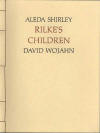 |
|
|
|
[Foreword] in Aleda Shirley [and] David Wojahn,
Rilke’s
Children. With a Foreword By Guy Davenport. Including Outstanding Entries By
Joe Servant, Rebecca Todd, Don Boes, Marcia L. Hurlow, Malcolm Glass, Linda Pannill and
Richard Speakes. Monterey, KY: Frankfort Arts Foundation, 1987. pp. [vii]-[x].
"This chapbook has been set in a stick in Emerson
& Palatino types. Printing was on a 10 x 15 C&P using Mohawk Letterpress paper.
420 numbered copies were printed by Jeff Edmondson & Gray Zeitz at Larkspur Press,
Monterey, Kentucky. Binding was done at the press. This is number: 85 [penciled
in]" p. [65]
|
|
|
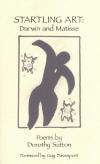 |
|
|
"Foreword"
in Startling Art: Darwin and Matisse. Poems by Dorothy
Sutton. Foreword by Guy Davenport. Cincinnati, OH: Finishing Line Press
Chapbooks, 1999. Cover art by Dorothy Sutton, 'Icarus Among the
Amoebae' after H. Matisse (verso title page).
"Three kinds of
prophets move in and out of the light and dark of these poems: the
scientist, the visual artist, and the poet who can show us that Charles
Darwin and Henri Matisse are as visionary as Daniel or Amos. Prophets
must see before they speak. Because the see with the eyes of genius,
they see anew what was there to be seen all along. . . .
The poet is interested
in everything, and that interest comes alive in sensual response. It is
feeling before it is thought. Romanticism gave feeling a bad name as a
diffuse and general emotion; the opposite of scientific observation. Yet
feeling is more apt to be as exacting and sharply focused. Darwin had a
mind as exact, and as exacting, as Leonardo's. Unlike Darwin, he was
creating a world rather than discovering the logic of creation itself,
as Darwin was. . . .
The fascinating thing
about Matisse's vivid liveliness is how many revisions he went through
to achieve it. Every painting evolved through version after version. So
did nature, Darwin showed us. Instead of being appalled by Evolution,
Darwin's first readers should have rejoiced that creation, far from
being finished on the first Saturday, is still going on like a house
afire, and will continue until time runs out. . . .
. . . Darwin's
descent of man was from an origin; other descents, like that of Icarus,
are tragic falls. Mankind has been in a tragic fall all of this century.
Our great hope is that the poets will guide us to when it will be
'artfully fused together again.' Dorothy Sutton's firm and careful
eloquence makes it seem imperative that we keep winnowing the past for
its enduring truths; that we keep entering rooms hung with paintings,
poetry and the other arts and sciences which speak revelations we'd
thought 'only lovers and nature could say.' (from the Foreword)
Note: Dorothy Sutton,
Professor of English at Eastern Kentucky University, Richmond KY,
completed the requirements for the PhD in English literature at the
University of Kentucky under the guidance of Guy Davenport. I found
Professor Sutton's chapbook in my mailbox Christmas Eve 2005 along with
her letter which explained that another Davenport reader, Charles
Godwin, learned of Startling Art: Darwin and Matisse while
searching the internet for Davenport books. Mr. Godwin requested a
copy of the chapbook for his collection, and then requested a copy be
sent to me. This was indeed a surprising, startling, Christmas
present.
|
|
|
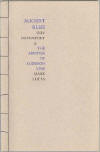 |
|
|
|
"August Blue" in
August Blue & The Aristeia of Audubon Vine. With an Introduction
by Richard Taylor, ([Frankfort, KY:] Frankfort Arts Foundation, 1992), pp. [1]-33.
"Guy Davenport's 'August Blue'
has appeared in Antaeus [64/65
(Spring-Autumn 1990) 196-207].
The publication of this chapbook was supported
in part by grants from the Kentucky Arts Council, Investors Heritage Life
Insurance Co. and Mr. & Mrs. Dandridge F. Walton." (verso title page)
"This chapbook was hand set in Joseph Blumenthal's Emerson
type. 250 copies were printed on Mohawk Letterpress paper with a hand-fed C & P.
Design, composition, press work & binding is by Dave Smith and Gray Zeitz at Larkspur
Press, 340 Sawdridge Creek W., Monterey, Ky. 40359. This is copy: [203 penciled in]"
(colophon)
"Introduction" by Richard Taylor, pp. ix-xiv.
Note:
Richard Taylor, from Louisville, KY, an attorney, completed his PhD in
English literature at the University of Kentucky under the guidance of Guy
Davenport.
|
|
|
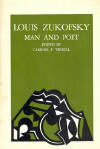 |
|
|
|
"Zukofsky's English Catullus" in Carroll F.
Terrell, ed., Louis Zukofsky: Man and Poet, (Orono, ME: National
Poetry Foundation [1979]), pp. [365]-370.
First published in Maps 5 (1973) 70-75.
|
|
| "From the Greek of Sappho" and "From
the Latin [sic] of Archilochus" in Charles Tomlinson, ed., The
Oxford Book
of Verse in English Translation, (Oxford: University Press, 1980), pp. 559-562. . |
|
|
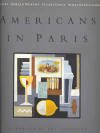 |
|
|
|
"Paris the Imaginary City" in Elizabeth
Hutton Turner, Americans in Paris (1921-1931): Man Ray, Gerald Murphy, Stuart
Davis, Alexander Calder., with essays by Elisabeth Garrity Ellis and Guy
Davenport. Washington, DC: Counterpoint Press, in association with the Phillips
Collection, Washington, DC, 1996, pp. 153-160.
Published on the occasion of the exhibition held April 27
through August 18, 1996, organized by The Phillips Collection.
|
|
|
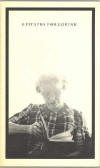 |
|
|
| "For Lorine Niedecker (On A Theme From Alkman)"
in Jonathan Williams, ed., Epitaphs For Lorine, (Penland, NC: The Jargon
Society, 1973), unpaged. |
|
|
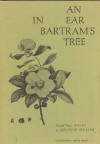 |
|
|
|
"Introduction" in Jonathan Williams, An
Ear in Bartram's Tree: Selected Poems 1957-1967, (Chapel Hill, NC: University of
North Carolina Press, 1969), unpaged.
Inscribed by the author on the occasion of JW's 50th birthday
party at the book shop, Books and Company in New York: "for Chuck -- all good things
-- from Jonathan 1979"
This book was reprinted: Norwalk, CT: New
Directions, 1972, essay at pp. 11-19.
This essay was published later (1969) as a
pamphlet by The Asphodel Book Shop, Cleveland, Ohio, entitled,
Jonathan
Williams, Poet.
|
|
|
|
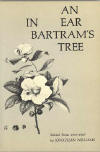 |
|
|
|
|
"Introduction" in Jonathan Williams, An
Ear in Bartram's Tree: Selected Poems 1957-1967, (1969; reprint New York:
New Directions, 1972), pp. [11-19]. |
|
|
|
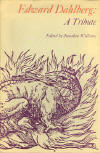 |
|
|
|
|
[Untitled Essay] in Jonathan Williams, ed.,
Edward
Dahlberg: A Tribute: Essays, Reminiscences, Correspondence, Tributes, (New
York: David Lewis, Inc., A TriQuarterly Book, 1970), pp. 117-119.
This book first appeared as TriQuarterly 20, Fall
1970. Copyright 1970 by Northwestern University Press
From JW's notes on contributors:
"Guy Davenport bides his time in Blue-Grass Limbo,
living among his 10,000 books, going nowhere, owning no motorcar. This has made for
a prodigious cultivation, the like of which is not seen in more than a handful per
generation. Professor Davenport tries to teach Calvin, Homer, Louis Agassiz, Ezra
Pound, Louis Zukofsky, and Stan Brakage to towheaded disciples who go to the university
bookstore and ask, "Do you have a poem book on e. e. cummings?" He does
reviews for Life, the New York Times, the National Review; he
draws elegantly for Arion and for books by Hugh Kenner. He translates
Archilochos and Sappho, Heraclitus and Alcman. He writes book-length poems like Flowers
& Leaves (Jargon Society) in which Ives and Pound mix with the ghosts of
Poliziano and Old Man Blake. He's a sight, as they say in his native South
Carolina, and one of the reasons the literary life in the United States is of occasional
pleasure."
|
|
|
|
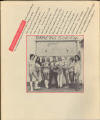 |
|
|
|
"Introduction" in Jonathan Williams,
Elite/Elate
Poems: Selected Poems 1971-1975. A Portfolio of Photographs by Guy
Mendes. Introduction by Guy Davenport. Notes by the Poet. (Highlands,
NC: The Jargon Society, 1979), pp. 15-18.
Cover title:
ELITE/ELATE POEMS by Jonathan Williams
are a selection from 1971-1975. Mr. Williams agrees
with Alexander Porfirevich Borodin
that "respectable people don't
write music or make love as a
career." . . . Among those you will
meet inside are the fabulous
'Little' Enis (aka Carlos Toadvine)
and those laughing Erinnys of the
Blue Grass, the Go-Go Girls of
Boots Bar, Lexington, Ky, seen
below in one of Guy Mendes's
portfolio of 13 photographs . . .
The poet advises his readers
(1) JUBILATE! -- there's plenty
more cornbread in the kitchen; and
(2) 'The American Depress Card
-- don't leave home without it!'"
|
|
|
|
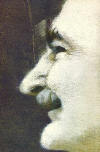 |
|
|
|
"For Basil Bunting" in Jonathan Williams,
ed., Madeira & Toasts For Basil Bunting's 75th Birthday,
(Dentale, England: The Jargon Society, March 1, 1975, c1977), p. 10.
Jargon 66. 1250 copies.
Excerpts from GD's poem:
Northumbrian master of
number and pitch. . . .
|
|
|
|
"Introduction" in Jonathan Williams,
Sharp
Tools For Catullan Gardens, (Bloomington, IN: Fine Arts Department, Indiana
University, 1968).
Note: I have a typescript of the "Introduction"
only, not the book.
Excerpt follows:
To Jonathan Williams, as to
all satirists, the world is either disjunct or wonderfully beautiful.
Satire, the most moral of visions, is like Pan's grin, at once startlingly
ugly and the essence of our sensual love of the world.
The connoisseur of freaks can usually be found at home in a garden. The
judiciously liberal mind, too grandly understanding to care about
differences, can find nothing to say about the ridiculous. Jonathan Williams
is a Calvinist Pan, a moralist who understands that mankind is most human in
its failures, and that the enormity of its failures is forever within the
inviolable geometry of God, so that to ove the beauty of a flower or the
contours of the striated muscles is to possess the elasticity whereby we can
abide impatiently, the jackass bray of the politician.
Honey and acid, the
sweetness of the one depends on the bite of the other. Jonathan Williams is
Greek, amoral, lyrical when he sings the green world. He is Roman, moral,
epigrammatic when he writes up mankind as it lives in its selfhood. I
suspect that Jonathan Williams has walked before the Lord at the Prophet
Blake's elbow, where the world is shown to be either transparent or opaque,
either Golganooza built by poets or Ulro built by the prudent. Golganooza
take off your britches and come in, the grass is good between the toes. Ulro:
no poor people, free people, or different people allowed."
|
|
|
|
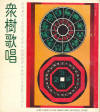 |
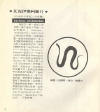 |
|
|
|
"Carmina Archilochos" in Wai-lim Yip,
trans., Ch'ung shu ko ch'ang. Translated by Yeh Wei-lien [i.e., Wai-lim Yip]
(Taipei: 1974), pp. 9-24. Paperback.
24 fragments of Archilochos, one to a page.
On the rear cover (front cover in the Occident) is the phrase
"Swinging on the Stars" beneath a zodiac within a polychrome cube.
|
|
|
|
 |
|
|
|
[Essay and Interview] in
Ralph Eugene Meatyard.
With an essay by Guy Davenport. [Edited with an Introduction by Cynthia
Young.] ( [Göttingen, Germany:] Steidl, [2004]), pp. 15-19 (essay) and pp.
21-31 (interview). "First edition 2004" (colophon)
"Published in conjunction with the
exhibition Ralph Eugene Meatyard organized by the International
Center of Photography. Exhibition dates: December 10, 2004 through
February 27, 2005. Co-published by the International Center of
Photography, New York and Steidl Publishers, Göttingen, Germany.
Editor: Cynthia Young" (colophon)
The ICP address: 1114 Avenue of the
Americas, New York, NY 10036 -- < www.icp.org >
Steidl Publishers: Düstere Str. 4 /
D-37073 Göttingen -- < [email protected] >
GD's essay "Ralph Eugene Meatyard" first
appeared in Ralph Eugene Meatyard (New York: Aperture, 1974) and
"appears here courtesy of the author."
"Interview with Guy Davenport" by Cynthia
Young (pp. 21-31) is dated "August 2004".
|
|
|
|
[Untitled Obituary of John Gardner] in Richard
Ziegfeld, ed.,
Dictionary of Literary Biography Yearbook: 1982, (Detroit:
Gale Research/Bruccoli Clark, 1983), p. 159. |
|
|
|
|
|
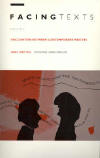 |
|
|
|
"The Jules Verne Steam Balloon" in Heide Ziegler, ed.,
Facing Texts:
Encounters Between Contemporary Writers and Critics. Durham, NC:
Duke University Press, 1988), pp 109-127.
Crane B48 --
"Followed by Joseph C. Schöpp essay,
'"Perfect Landscape with Pastoral Figures'": Guy Davenport's Danish
Eclogue ā la Fourier' (pp. 128-139) . . ." (Crane, p. 109),
|
|
|
|
|
|
Back to Parts of
Books (All) |















